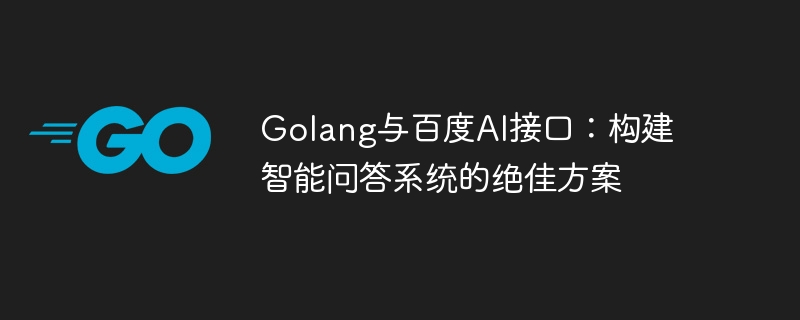

Golang and Baidu AI interface: an excellent solution to build an intelligent question and answer system
Introduction:
With the development of artificial intelligence technology and the increase in application scenarios, Intelligent question answering systems play an important role in various fields. Building an intelligent question answering system requires complex technologies such as Natural Language Processing (NLP) and machine learning. Fortunately, Baidu provides a series of powerful AI interfaces, including natural language processing, image recognition, etc. Developers can use these interfaces to quickly build intelligent applications. This article will introduce how to use Golang language and Baidu AI interface to build an excellent solution for an intelligent question and answer system.
1. Installation preparation
Before using Golang and Baidu AI interface, we need to install Golang and a Baidu developer account with Baidu AI interface permissions.
Golang installation
Go to Golang official website (https://golang.org/dl/) to download the binary package corresponding to the operating system and install it according to the operating system. After the installation is complete, enter the following command through the terminal to verify whether Golang is installed successfully.
$ go version
If the Golang version number is displayed correctly, Golang has been successfully installed.
2. Call Baidu AI Q&A interface
In building an intelligent Q&A system, we need to call the Q&A interface provided by Baidu AI to input questions and output answers. The following is a sample program that demonstrates how to use Golang to call Baidu AI's question and answer interface.
package main
import (
"fmt"
"io/ioutil"
"net/http"
"strings"
)
func main() {
apiKey := "YOUR_API_KEY" // 替换为自己的API Key
secretKey := "YOUR_SECRET_KEY" // 替换为自己的Secret Key
question := "北京的天气如何?" // 待提问的问题
client := &http.Client{}
req, err := http.NewRequest("POST", "https://aip.baidubce.com/rpc/2.0/unit/bot/chat", strings.NewReader(question))
if err != nil {
fmt.Println("New request error:", err)
return
}
req.Header.Add("Content-Type", "application/json")
req.Header.Add("charset", "UTF-8")
q := req.URL.Query()
q.Add("access_token", getToken(apiKey, secretKey))
req.URL.RawQuery = q.Encode()
resp, err := client.Do(req)
if err != nil {
fmt.Println("Send request error:", err)
return
}
defer resp.Body.Close()
body, err := ioutil.ReadAll(resp.Body)
if err != nil {
fmt.Println("Read response error:", err)
return
}
fmt.Println(string(body))
}
func getToken(apiKey, secretKey string) string {
// 调用百度AI的获取token接口,获取访问令牌
// 省略获取访问令牌的代码
return "YOUR_ACCESS_TOKEN" // 替换为实际获取到的访问令牌
}In the above example, we need to replace apiKey and secretKey with the API Key and Secret Key we obtained in the Baidu AI console. question is the question to be asked and can be modified according to needs. Run the code and you will get a JSON response of the answer.
3. Extension of the intelligent question and answer system
By calling Baidu AI’s question and answer interface, we can build a basic intelligent question and answer system. However, in order to improve the performance and user experience of the system, we can further expand and optimize the system, as follows:
Summary:
This article introduces how to use Golang and Baidu AI interface to build a solution for an intelligent question and answer system. By calling Baidu AI's question and answer interface, we can quickly build a natural language-based question and answer system. At the same time, we can also expand and optimize the system to improve system performance and user experience. We hope that the introduction in this article can help developers better use Golang and Baidu AI interfaces to build intelligent applications.
The above is the detailed content of Golang and Baidu AI interface: an excellent solution for building an intelligent question and answer system. For more information, please follow other related articles on the PHP Chinese website!
 How to define variables in golang
How to define variables in golang
 What are the data conversion methods in golang?
What are the data conversion methods in golang?
 What are the commonly used libraries in golang?
What are the commonly used libraries in golang?
 What is the difference between golang and python
What is the difference between golang and python
 How much is Snapdragon 8gen2 equivalent to Apple?
How much is Snapdragon 8gen2 equivalent to Apple?
 The m2m concept in the Internet of Things
The m2m concept in the Internet of Things
 navigator.useragent
navigator.useragent
 The relationship between js and vue
The relationship between js and vue
 Introduction to parametric modeling software
Introduction to parametric modeling software




